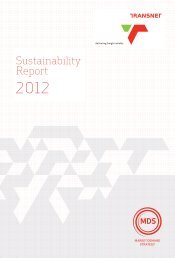Socio Economic - Transnet
Socio Economic - Transnet
Socio Economic - Transnet
- No tags were found...
Create successful ePaper yourself
Turn your PDF publications into a flip-book with our unique Google optimized e-Paper software.
The most noticeable is the differential growth rates in employment creation between the sectors.Agriculture has shown an average decrease of about 7.5% of the jobs between 2011 and 1995. Theimplication is important since these workers are jobless and have to leave farms. They usually end upin informal settlements on the urban fringes. This amounts to about 7886 people being affected or itimplies a need for about 2 500 new households to be provided with services. The primary andsecondary sectors are both shedding jobs while the tertiary sector is growing strongly andemphasising the role of the Msukaligwa Municipality.3.3.2.2 Changes in employmentTable 8 below presents the employment distribution per sector over the past 17 years. These figuresare expressed in terms of the distribution of employment across the sectors. One noticeable aspect isthat the largest economic sectors are not necessarily the biggest contributors to employment creation.Table 8: Employment distribution per sectorAgriculture, forestry andfishingMining and quarryingManufacturingElectricity, gas and waterConstructionWholesale and retail trade,catering andaccommodationTG: Transport, storage andcommunication [SIC: 7]TH: Finance, insurance, realestate and business services[SIC: 8]TI: Community, social andpersonal services [SIC: 92,95-6, 99, 0]TJ: General government[SIC: 91, 94]Total1995 36% 7% 7% 1% 6% 16% 4% 5% 9% 8% 100%1996 36% 7% 7% 1% 6% 16% 4% 6% 9% 9% 100%1997 36% 7% 7% 1% 5% 16% 4% 6% 9% 9% 100%1998 36% 6% 7% 1% 5% 17% 4% 6% 10% 9% 100%1999 35% 6% 7% 1% 4% 18% 3% 6% 10% 9% 100%2000 34% 6% 7% 1% 4% 19% 3% 6% 11% 9% 100%2001 30% 6% 8% 1% 4% 21% 3% 7% 12% 10% 100%2002 27% 5% 8% 1% 4% 23% 4% 7% 12% 10% 100%2003 25% 5% 8% 1% 4% 23% 4% 8% 13% 11% 100%2004 23% 4% 8% 1% 4% 24% 4% 8% 13% 11% 100%2005 22% 4% 7% 1% 4% 26% 5% 7% 13% 11% 100%2006 21% 4% 7% 1% 5% 27% 5% 7% 13% 11% 100%2007 18% 4% 6% 1% 5% 28% 5% 7% 13% 12% 100%2008 14% 4% 6% 1% 5% 30% 5% 7% 14% 13% 100%2009 12% 4% 5% 2% 5% 32% 5% 7% 15% 14% 100%2010 11% 5% 5% 2% 4% 32% 6% 7% 15% 14% 100%2011 11% 5% 4% 2% 5% 32% 6% 7% 14% 15% 100%From Table 8 it is confirmed that employment is not a static issue and changes in employment arevery important. Figure 11 below gives a comparison between the employment situation in 1995 and in2011.5 July 2013 Page 18
















